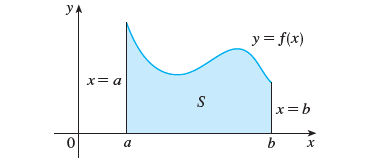ESTIMATE AREA UNDER CURVE USING MIDPOINT RIEMANN SUMS
Subscribe to our ▶️ YouTube channel 🔴 for the latest videos, updates, and tips.
Consider the function y = f(x) from a to b. This means that S illustrated is the picture given below is bounded by the graph of a continuous function f, the vertical lines x = a, x = b and x axis.


We approximate the region S by rectangles and then we take limit of the areas of these rectangles as we increase the number of rectangles. The following example illustrates the procedure.
Approximate Area Under Curve Using Midpoints
Example 1 :
Estimate the area under the graph f(x) = 1 + x2 from x = -1 to x = 2 using three rectangles using right end points.
Solution :
Δx = (b - a)/n
a = -1, b = 2 and number of rectangles (n) = 3
Δx = (2 + 1)/3
Δx = 1
We can approximate each strip by that has the same base as the strip and whose height is the same as the right edge of the strip. Each rectangle has the width of 1.
Sub intervals are [-1, 0], [0, 1] and [1, 2].
Midpoint of [-1, 0] is
= (-1 + 0)/2
= -1/2
Midpoint of [0, 1] is
= (0 + 1)/2
= 1/2
Midpoint of [1, 2] is
= (1 + 2)/2
= 3/2
Approximating area using mid points :
x1 = -1/2, x2 = 1/2, and x3 = 3/2
f(x) = 1 + x2
f(-1/2) = 1 + (1/2)2 = 5/4
f(1/2) = 1 + (1/2)2 = 5/4
f(3/2) = 1 + (3/2)2 = 13/4
Approximate area
= 1 (5/4 + 5/4 + 13/4)
= 1(23/4)
≈ 5.75
So the approximate area is 5.75.
Example 2 :
Graph the function
f(x) = x - 2 lnx 1 ≤ x ≤ 5
Estimate the area under the graph using four approximating rectangles and taking the sample points as midpoints.
Solution :
Δx = (b - a)/n
a = 1, b = 5 and number of rectangles (n) = 4
Δx = (5 - 1)/4
Δx = 4/4
Δx = 1

We can approximate each strip by that has the same base as the strip and whose height is the same as the right edge of the strip. Each rectangle has the width of 1.
Sub intervals are [1, 2], [2, 3] [3, 4] and [4, 5].
Midpoint of [1, 2] is
= (2 + 1)/2
= 3/2
= 1.5
Midpoint of [2, 3] is
= (3 + 4)/2
= 2.5
Midpoint of [3, 4] is
= (3 + 4)/2
= 3.5
Midpoint of [4, 5] is
= (5 + 4)/4
= 4.5
Approximating area using mid points :
x1 = 1.5, x2 = 2.5, x3 = 3.5 and x4 = 4.5
f(x) = x - 2lnx
f(1.5) = 1.5 - 2ln(1.5)
= 1.5 - 2(0.41)
= 1.5 - 0.82
= 0.68
f(2.5) = 2.5 - 2(0.91)
= 2.5 - 1.82
= 0.68
f(3.5) = 3.5 - 2ln(3.5)
= 3.5 - 2(1.25)
= 3.5 - 2.5
= 1
f(4.5) = 4.5 - 2ln(4.5)
= 4.5 - 2(1.50)
= 4.5 - 3
= 1.5
Required Area ≈ 1[0.68 + 0.68 + 1 + 1.5]
= 3.86
So, the required area is about 3.86.
Subscribe to our ▶️ YouTube channel 🔴 for the latest videos, updates, and tips.
Kindly mail your feedback to v4formath@gmail.com
We always appreciate your feedback.
About Us | Contact Us | Privacy Policy
©All rights reserved. onlinemath4all.com

Recent Articles
-
10 Hard SAT Math Questions (Part - 42)
Dec 30, 25 05:52 AM
10 Hard SAT Math Questions (Part - 42) -
10 Hard SAT Math Questions (Part - 38)
Dec 29, 25 04:21 AM
10 Hard SAT Math Questions (Part - 38) -
10 Hard SAT Math Questions (Part - 39)
Dec 28, 25 11:20 PM
10 Hard SAT Math Questions (Part - 39)
